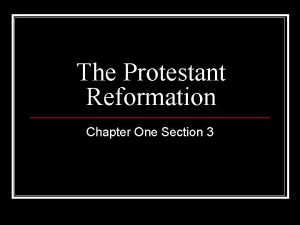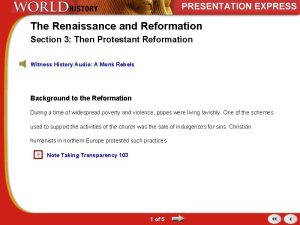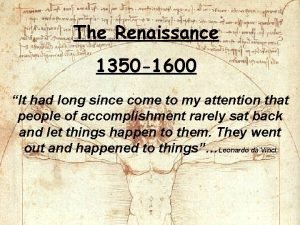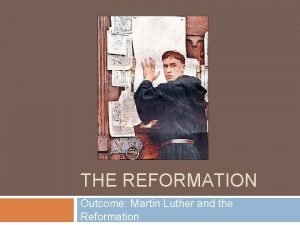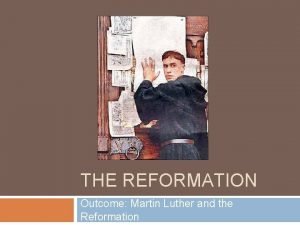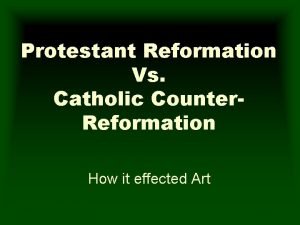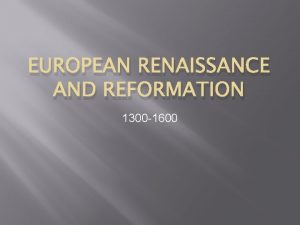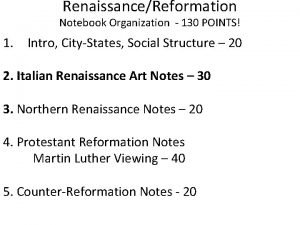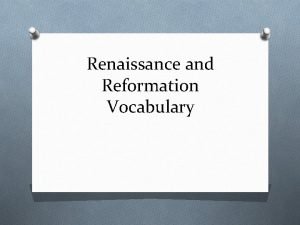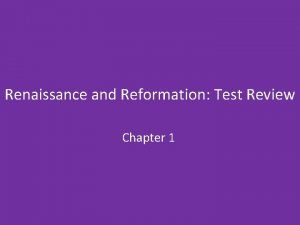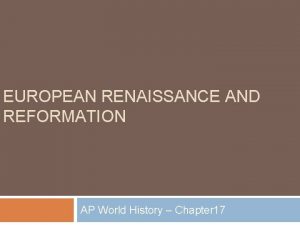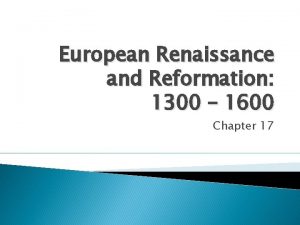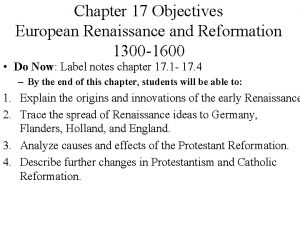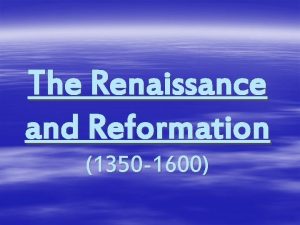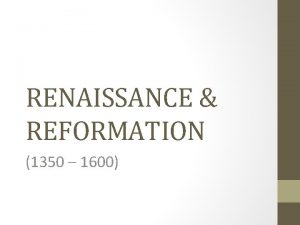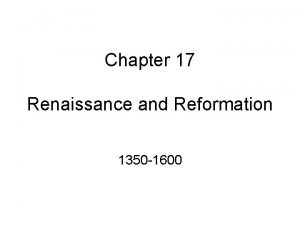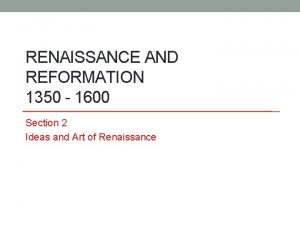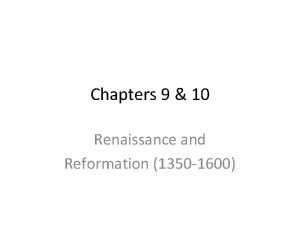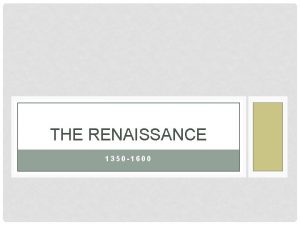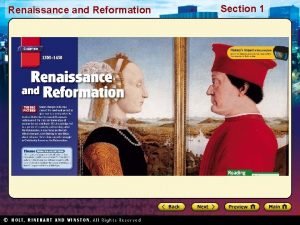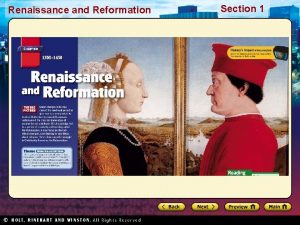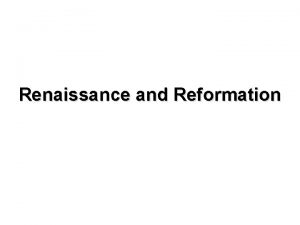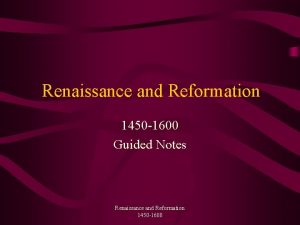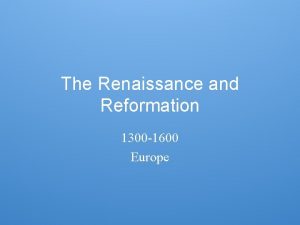Renaissance and Reformation 1350 1600 Section 1 The
















- Slides: 16

Renaissance and Reformation 1350 - 1600 Section 1 The Renaissance

Background Beginning in Italy and spanning two centuries, the Renaissance emphasized secularism, awareness of ties to the ancient Greek and Roman worlds, and the ability of the individual. City states became centers of political, economic, and social life. Machiavelli influenced political thought, and Castiglione defined what made a perfect Renaissance noble. The Renaissance affected everyone from noble to peasant

Renaissance Italy, 1500 Three citystates that played crucial roles Milan, Venice, and Florence

Italian Renaissance u Renaissance means “rebirth” u Belief in a rebirth of ancient Greece and Roman worlds

Characteristics of Renaissance Italy Urban Society – powerful city states, centers of political, economic, and social life which created the emergence of secular or worldly viewpoints. u Age of recovery from plague, political instability, and decline of Catholic church. u Emphasized an individual’s ability and a higher regard for human worth. u A universal person would achieve things in many areas (i. e. Leonardo da Vinci who was a painter, sculpture, architect, inventor, and mathematician. u

Italian States u u u Lack of a single strong ruler made it possible for a number of city-states in northern and southern Italy to remain independent Three largest were Milan, Venice, and Florence. These three played a critical role in Italian politics.

Milan u Located in northern Italy u Ruled by the Visconti family and Sforza dukes u Based on trade and an efficient tax system

Venice u Located in northern Italy u Ruled by a small group of wealthy merchant-aristocrats who ran government for their own benefit u Based on trade

Florence u Cultural center u Ruled by the wealthy Medici family

Italian Wars Growth of monarchies in rest of Europe led to trouble for the Italian states. u Wanted Italy for its rich resources. u French King Charles VIII led an army of 30, 000 men into Italy in 1494. Occupied the kingdom of Naples, to the south. Italy received help from Spain who fought with the French for 30 years and eventually won creating a dominate force in Italy. u

“The Prince” The Italians of the Renaissance had love of political power. Niccolo Machiavelli wrote one of the most influential works on political power in the Western world, The Prince. u u Book written by Machiavelli on how to acquire and keep political power Did not believe that the prince (or ruler) should rule based on moral principles, but on the principle that humans were self-centered and not moral. Morality had nothing to do with politics and a ruler must let his conscience sleep.

In the Middle Ages, many writers on political power had stressed the moral side of a prince’s activity – how the ruler ought to behave based on Christian principles. Machiavelli rejected this popular approach. From Machiavelli’s point of view, a prince’s attitude toward power must be based on an understanding of human nature, which he believed was basically self-centered. A prince acts on behalf of the state not morals.

Renaissance Society Social Classes (Estates) Nobility (3% of population) u Held political jobs, advised the king u Noble birth, have education, interest in the arts, follow conduct rules Peasants (90% of population) u Became free from serfdom Townspeople (7% of population) u Patricians: wealthy top level u Burgher: Shopkeepers, artisans, guild masters. u Workers and unemployed: extremely poor, lived miserable lives.

Renaissance Life Nobility Peasant Market

Family and Marriage Family bond was a great source of security u Marriage arranged to strengthen business or family ties u Father managed all finances, made all decisions, absolute rule over children until he died or freed them before a judge. u Mother supervised household only, had no say in children’s lives or any decisions u

Summary Questions Draw a line underneath your last notes and answer the following questions. Review your notes if you need help. Be prepared to be called on. 1. The Renaissance was a “rebirth” of what? 2. What were three largest city-states of the Renaissance? 3. Who was the author of The Prince and what was it’s main theme? 4. What were three social classes or estates?
 Give up one’s views or beliefs
Give up one’s views or beliefs The renaissance and reformation section 3 quiz
The renaissance and reformation section 3 quiz Thermometer inventor
Thermometer inventor It had long since come to my attention
It had long since come to my attention The reformation outcome: martin luther and the reformation
The reformation outcome: martin luther and the reformation The reformation outcome martin luther and the reformation
The reformation outcome martin luther and the reformation Protestants vs catholics
Protestants vs catholics What is the “renaissance rebirth?”
What is the “renaissance rebirth?” Historical events in the renaissance
Historical events in the renaissance Who wrote praise of folly
Who wrote praise of folly Topic 4 the renaissance and reformation
Topic 4 the renaissance and reformation Renaissance and reformation interactive notebook
Renaissance and reformation interactive notebook Renaissance and reformation vocabulary
Renaissance and reformation vocabulary A thriving trading region where the renaissance began
A thriving trading region where the renaissance began European renaissance and reformation answer key
European renaissance and reformation answer key Chapter 17 european renaissance and reformation
Chapter 17 european renaissance and reformation European renaissance and reformation chapter 17
European renaissance and reformation chapter 17
